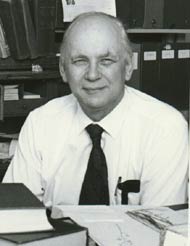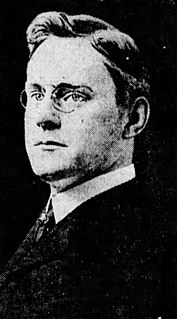
Nathaniel Lord Britton was an American botanist and taxonomist who co-founded the New York Botanical Garden in the Bronx, New York.

Arthur John Cronquist was an American biologist, botanist and a specialist on Compositae. He is considered one of the most influential botanists of the 20th century, largely due to his formulation of the Cronquist system as well as being the primary co-author to the Flora of the Pacific Northwest, still the most up to date flora for three northwest U.S. States to date. Two plant genera in the aster family have been named in his honor. These are Cronquistia, a possible synonym of Carphochaete, and Cronquistianthus, which is sometimes included as a group within Eupatorium. The former was applied by R.M. King and the latter by him and Harold E. Robinson.

The Polyporaceae are a family of poroid fungi belonging to the Basidiomycota. The flesh of their fruit bodies varies from soft to very tough. Most members of this family have their hymenium in vertical pores on the underside of the caps, but some of them have gills or gill-like structures. Many species are brackets, but others have a definite stipe – for example, Polyporus badius.
Torrey Botanical Society was started in the 1860s by colleagues of John Torrey. It is the oldest botanical society in the Americas. The Society promotes the exploration and study of plant life, with particular focus on the flora of the regions surrounding New York City. Members of the group including Nathaniel Lord Britton and his wife Elizabeth Gertrude Britton founded the New York Botanical Garden.
Dicliptera aripoensis is a species of plant in the family Acanthaceae which is endemic to Trinidad and Tobago. The species is only known from the Heights of Aripo, in Trinidad's Northern Range. It is a branching shrub, 1–1.5 m tall with red flowers about 3 cm long.

Sabal etonia, commonly known as the scrub palmetto is a species of palm. It is native only to peninsular Florida in the United States, where it is found in Florida sand pine scrub communities.

Lucien Marcus Underwood was an American botanist and mycologist of the 19th and early 20th centuries.
Forest Buffen Harkness Brown (1873–1954) was an American botanist known for his work on pteridophytes and spermatophytes.

Mitrastemon is a genus of two widely disjunct species of parasitic plants. It is the only genus within the family Mitrastemonaceae. Mitrastemon species are root endoparasites, which grow on Fagaceae. It is also a non-photosynthetic plant that parasitizes other plants such as Castanopsis sieboldii. The parasitic plant was first discovered by botanist Eizi Matuda during an expedition to Mt. Ovand in the state of Chiapas, Mexico. The different species were originally named by a friend of Matuda, Yamamoto in 1925–1926. Mitrastemon yamamotoi is a protandrous plant. Its flowers go through a male phase before transforming into their final female form. The flowers of M. yamamotoi attract a variety of insects ranging from wasps to flies and beetles. Among these, beetles are the best pollinators for this plant since their visit to the flower would pick up a large amount of pollen and they would pollinate from each of the flowers that they had already visited.The plant is endemic to tropical and subtropical forest regions such as Southeast Asia and Japan.

Elizabeth Gertrude Britton was an American botanist, bryologist, and educator. She and her husband, Nathaniel Lord Britton played a significant role in the fundraising and creation of the New York Botanical Garden. She was a co-founder of the predecessor to the American Bryological and Lichenological Society. She was an activist for protection of wildflowers, inspiring local chapter activities and the passage of legislation. Elizabeth Britton made major contributions to the literature of mosses, publishing 170 papers in that field.
Elizabeth Jill Cowley is a British botanist, who has worked at the Royal Botanic Gardens, Kew. Her interests have included the tropical flora of East Africa and the genus Roscoea.

Anna Murray Vail was an American botanist and first librarian of the New York Botanical Garden. She was a student of the Columbia University botanist and geologist Nathaniel Lord Britton, with whom she helped to found the New York Botanical Garden.

Nellie Adalesa Brown (1876–1956) was an American botanist and government researcher. Much of her research focused on plant pathology. While working with Charles Orrin Townsend and Agnes J. Quirk as assistants for Erwin Frink Smith, Brown and her colleagues described Agrobacterium tumefaciens, the organism responsible for crown gall in 1907. They also identified methods of mitigation.
Henry Hurd Rusby (1855–1940) was an American botanist, pharmacist and explorer. He discovered several new species of plants and played a significant role in founding the New York Botanical Garden and developing research and exploration programs at the institution. He helped to establish the field of economic botany, and left a collection of research and published works in botany and pharmacology.
Edward Lyman Morris (1870–1913) was an American botanist.

Charles Stuart Gager was an American botanist who served as director of the Brooklyn Botanic Garden for over 30 years. He served as president of the Botanical Society of America and the Torrey Botanical Club. Born in Norwich, New York, he graduated from Syracuse University in 1895, and earned a PhD at Cornell in 1902. Between 1895 and 1910 he taught biology and botany at New York State Normal College, Rutgers University, New York University, and the University of Missouri, and was laboratory director at the New York Botanical Garden. He was called to direct the Brooklyn Botanical Garden in 1910, and under his directorship the Garden expanded its role in public education, especially children's education. His works include the textbooks Fundamentals of Botany (1916) and General Botany, with Special Reference to its Economic Aspects (1926). He died in Waterville, Maine.
Willard Webster Eggleston was an American botanist, employed by the United States Department of Agriculture Bureau of Plant Industry. He graduated from Dartmouth College in 1891 with a Bachelor of Science degree. In his work on the taxonomy of Crataegus, now known to be complicated by apomixis, polyploidy, and hybridization, he aimed to simplify, counteracting the proliferation of species names that other botanists had produced.
Violetta White Delafield, née Violetta Susan Elizabeth White, (1875–1949) was an American botanist, mycologist, scientific illustrator and horticulturist.

George Newton Best was an American bryologist, expert on moss taxonomy, and second president of the Sullivant Moss Society.
Brian Morey Boom is an American botanist who specializes in the flora of the Guianas and the Caribbean, the family Rubiaceae, ethnobotany, and economic botany.










